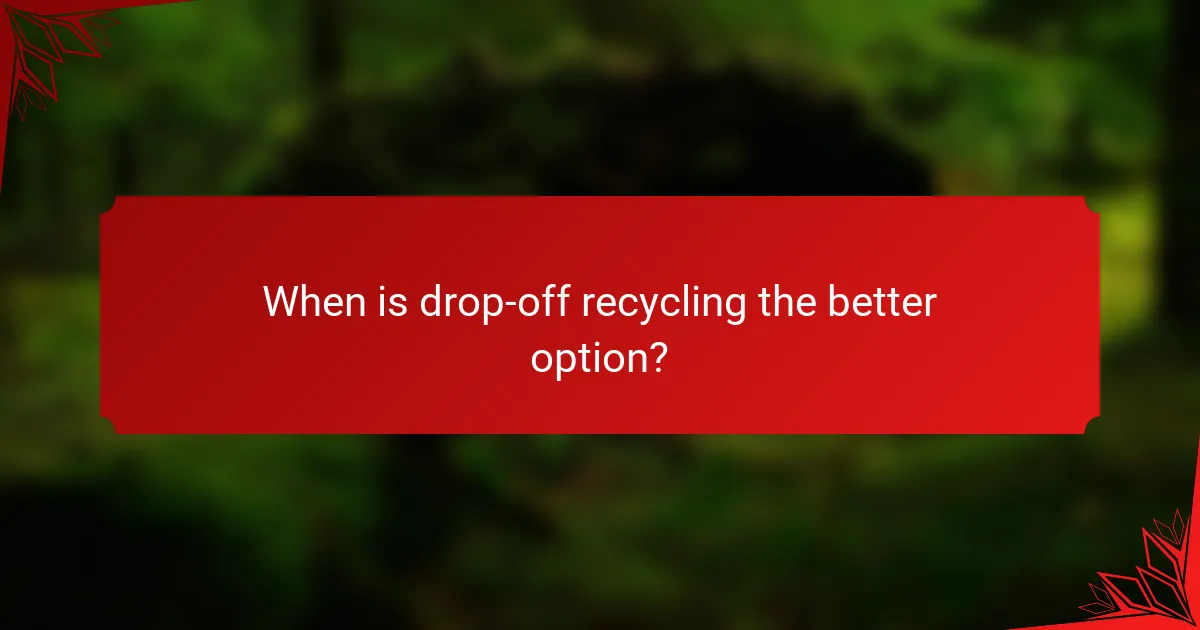When it comes to recycling, choosing between curbside and drop-off programs can significantly impact community participation and environmental outcomes. Curbside recycling offers convenience and encourages higher participation rates, while drop-off programs provide flexibility for specific materials and can be more cost-effective. Understanding the strengths of each option can help communities make informed decisions about their recycling strategies.

What are the benefits of curbside recycling programs?
Curbside recycling programs offer significant advantages, including convenience for residents, increased participation rates, and reduced contamination risks. These benefits contribute to more effective recycling efforts and a cleaner environment.
Convenience for residents
Curbside recycling programs provide an easy and accessible way for residents to recycle without needing to travel to a drop-off location. By placing recycling bins at the curb, residents can simply set out their recyclables alongside their regular trash, making the process seamless.
This convenience encourages more households to participate, as it eliminates the barriers associated with transporting materials to recycling centers. Many programs operate on a regular schedule, allowing residents to plan their recycling efforts efficiently.
Increased participation rates
The ease of curbside recycling often leads to higher participation rates compared to drop-off programs. Studies indicate that communities with curbside services can see participation levels in the high seventies to low eighties percent, significantly higher than those relying on drop-off locations.
When recycling is made simple and integrated into regular waste management, more residents are likely to engage. This increased participation helps divert more materials from landfills, contributing to sustainability goals.
Reduced contamination risks
Curbside recycling programs can help lower contamination rates in recyclable materials. When residents can easily recycle at home, they are more likely to follow guidelines and sort materials correctly, reducing the chances of non-recyclables being mixed in.
Many curbside programs provide clear instructions and educational resources, which further assist residents in understanding what can and cannot be recycled. This clarity helps maintain the quality of the recycling stream, ensuring that more materials are processed effectively.

What are the benefits of drop-off recycling programs?
Drop-off recycling programs offer several advantages, including convenience for specific materials and lower operational costs. These programs allow individuals to recycle items that may not be accepted through curbside collection, making them a valuable option for communities.
Accessibility for specific materials
Drop-off recycling programs often accept a wider variety of materials compared to curbside services. For example, items like electronics, batteries, and certain plastics may only be accepted at designated drop-off locations. This accessibility ensures that residents can properly recycle materials that would otherwise end up in landfills.
Communities can set specific drop-off days or locations to facilitate recycling of these materials, making it easier for residents to participate. By providing clear guidelines on what can be recycled, these programs help reduce contamination and improve overall recycling rates.
Lower operational costs
Drop-off recycling programs typically incur lower operational costs than curbside collection. Without the need for dedicated collection vehicles and personnel, municipalities can save on fuel and labor expenses. This cost-effectiveness can lead to more sustainable recycling initiatives.
Moreover, drop-off centers can be strategically placed in areas with high foot traffic, reducing the need for extensive collection routes. This approach not only saves money but also encourages community engagement in recycling efforts.
Flexibility for large volumes
Drop-off recycling programs provide flexibility for individuals and businesses with large volumes of recyclable materials. For instance, a local business can transport bulk recyclables to a drop-off center when convenient, rather than waiting for scheduled curbside pickups.
This flexibility is particularly beneficial during events or clean-up drives, where large quantities of recyclables are generated. By allowing users to drop off materials at their convenience, these programs can accommodate varying recycling needs effectively.

When should you choose curbside recycling?
Curbside recycling is ideal when convenience and accessibility are priorities for residents. This program allows individuals to place recyclable materials at the curb for collection, making it easier for households to participate regularly.
High population density areas
Curbside recycling is particularly beneficial in high population density areas where many residents live in close proximity. In these settings, the convenience of having recyclables picked up at the curb encourages participation and reduces littering.
For example, urban neighborhoods with apartment buildings or townhouses often rely on curbside services to manage waste effectively. This approach minimizes the need for residents to travel to distant drop-off locations.
Limited space for drop-off sites
In regions where space is at a premium, curbside recycling can be a more practical solution than drop-off sites. Limited land availability may restrict the establishment of accessible recycling centers, making curbside collection a more efficient alternative.
For instance, cities with small lots or high real estate costs may find it challenging to create drop-off facilities, while curbside pickup can be integrated into existing waste management systems without requiring additional space.
Regular waste collection schedules
Curbside recycling works best when it aligns with regular waste collection schedules, allowing residents to manage their recyclables alongside their general waste. This synchronization helps ensure that recycling becomes a routine part of waste disposal.
Communities that have designated days for waste and recycling collection can maximize participation by making it easy for residents to remember when to set out their materials. For example, if trash is collected every Tuesday, scheduling recycling for the same day can enhance compliance.

When is drop-off recycling the better option?
Drop-off recycling is often the better option when curbside services are limited or when specific materials need to be recycled. This method allows individuals to take their recyclables to designated locations, making it a practical choice for certain communities and situations.
Rural or low-density regions
In rural or low-density areas, curbside recycling may not be feasible due to the cost and logistics of servicing scattered populations. Drop-off recycling centers can effectively serve these communities, providing a centralized location for residents to bring their materials. This approach reduces transportation costs and ensures that recycling services are accessible without the need for extensive routes.
Specialized material recycling needs
Some materials, such as electronics, batteries, or hazardous waste, often require specialized recycling processes not available through standard curbside programs. Drop-off recycling allows individuals to dispose of these items safely at designated facilities that are equipped to handle them. It’s essential to check local guidelines to find out which materials can be accepted and the specific drop-off locations available.
Temporary recycling events
Temporary recycling events, such as community clean-up days or seasonal collection drives, provide an excellent opportunity for drop-off recycling. These events often focus on specific materials or large quantities that may not fit in regular curbside bins. Participating in these events can help residents declutter while ensuring that items are recycled properly and efficiently.

How do curbside and drop-off programs compare?
Curbside and drop-off recycling programs each offer distinct advantages and challenges. Curbside programs provide convenience by collecting recyclables directly from homes, while drop-off programs require individuals to transport materials to designated locations, often promoting greater community involvement.
Cost-effectiveness analysis
Curbside recycling programs typically incur higher operational costs due to the need for collection vehicles and labor. In contrast, drop-off programs can be more cost-effective as they require fewer resources and can rely on community volunteers. However, the initial setup costs for drop-off centers can vary significantly based on location and infrastructure.
When evaluating cost-effectiveness, consider factors such as local population density and the volume of recyclables generated. Urban areas may benefit more from curbside services, while rural regions might find drop-off options more sustainable.
Environmental impact assessments
Both curbside and drop-off recycling programs aim to reduce landfill waste and promote recycling, but their environmental impacts can differ. Curbside programs often lead to higher participation rates, which can increase overall recycling volumes. However, the carbon footprint from collection vehicles can offset some of these gains.
Drop-off programs may encourage responsible recycling habits, as individuals must actively engage in the process. This can lead to better sorting practices, but lower participation might result in less material being recycled overall. Assessing local waste management goals can help determine which program aligns better with environmental objectives.
Community engagement metrics
Community engagement is crucial for the success of recycling initiatives. Curbside programs often rely on consistent participation, which can be influenced by awareness campaigns and ease of use. Metrics such as participation rates and contamination levels can provide insights into community involvement.
Drop-off programs can foster a sense of community ownership and responsibility, as residents actively contribute to recycling efforts. Tracking volunteer hours and attendance at drop-off events can help gauge community engagement. Ultimately, the choice between these programs may depend on the specific needs and preferences of the local population.


